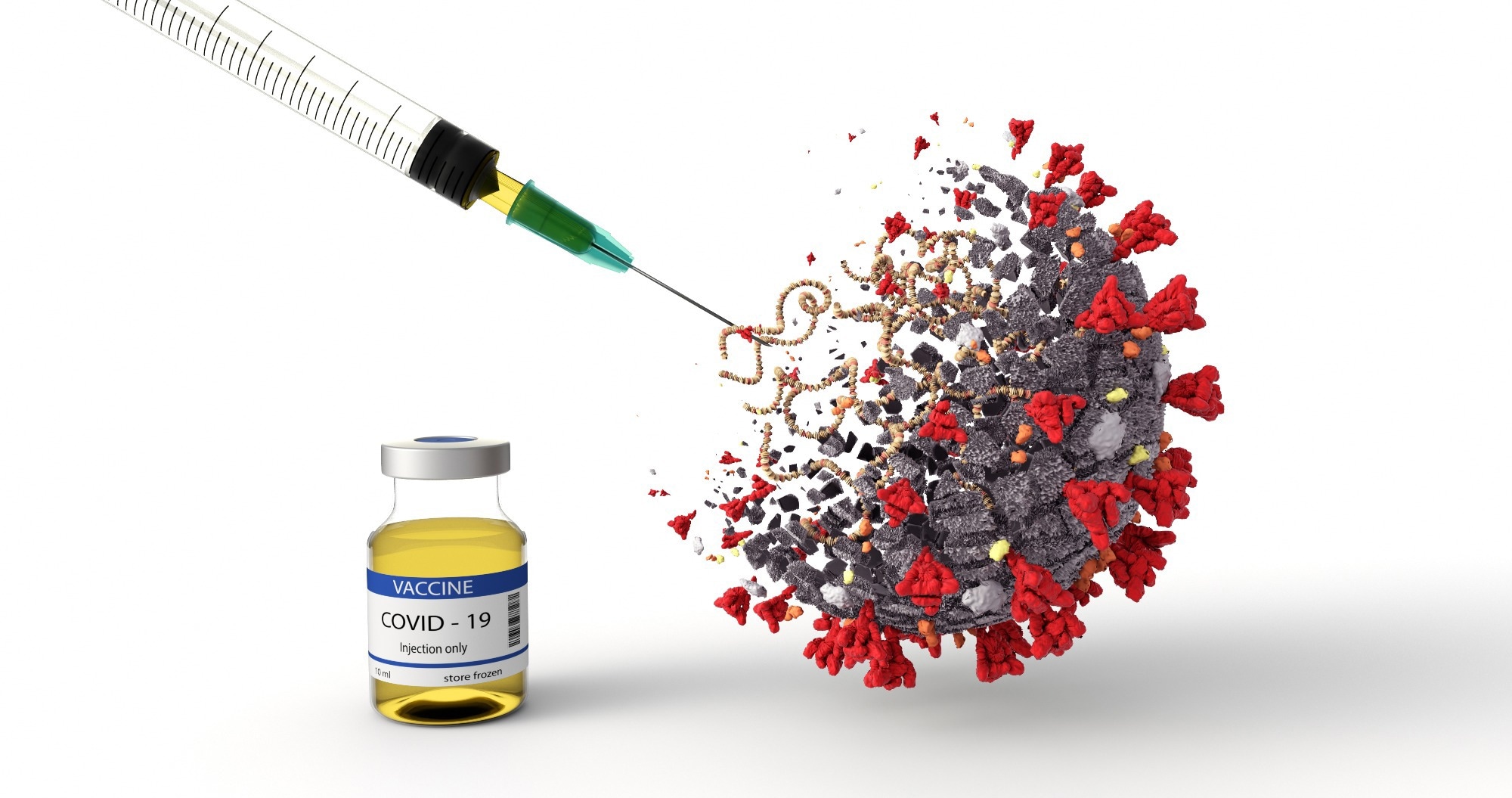Studies have reported that COVID-19 vaccines confer immune protection against severe acute respiratory syndrome coronavirus 2 (SARS-CoV-2) infections by inducing antibody (Ab)-based humoral and T lymphocyte-based cellular immune responses. However, there has not yet been an extensive examination of the mechanisms that underlie COVID-19 vaccines.
 Study: Comparative multi-OMICS single-cell atlas of five COVID-19 (rAdVV and mRNA) vaccines describe unique and distinct mechanisms of action. Image Credit: Orpheus FX / Shutterstock
Study: Comparative multi-OMICS single-cell atlas of five COVID-19 (rAdVV and mRNA) vaccines describe unique and distinct mechanisms of action. Image Credit: Orpheus FX / Shutterstock

 *Important notice: bioRxiv publishes preliminary scientific reports that are not peer-reviewed and, therefore, should not be regarded as conclusive, guide clinical practice/health-related behavior, or treated as established information.
*Important notice: bioRxiv publishes preliminary scientific reports that are not peer-reviewed and, therefore, should not be regarded as conclusive, guide clinical practice/health-related behavior, or treated as established information.
About the study
In the present longitudinal study, researchers investigated the immunogenicity and mechanisms of action of five different COVID-19 vaccines based on the rAdVV [Ad26.CoV2.S by Johnson & Johnson or Janssen (JJ), ChAdOx1 nCoV-19 by AstraZeneca (AZ)] and mRNA Pfizer/BioNTech’s (PB) BNT162b1 (PB), Moderna (MD)’s mRNA-1273; CureVac (CV)’s CVnCV] vaccination platforms.
Multi-OMICS transcriptomic analysis was performed, and humoral Ab titers and cellular immune response markers were assessed. AZ or mixed AZ and PB, JJ, PB, MD, and CV were administered to four, three, fifteen, three, and three participants, respectively. JJ-vaccinated participants received only single vaccination.
Serum samples were obtained pre-vaccination (PrV1, n=23), after seven to 10 days of the first vaccination (PoV1), and after the second, third, and fourth vaccinations. Individuals were administered second vaccination (PoV2) one to three months after PoV1. The third vaccination (PoV3) was administered six months after PoV2, and the fourth vaccination (PoV4) four to six months after PoV3.
The study cohort was divided into two groups. The first group comprised 28 unvaccinated and vaccinated persons. Peripheral blood mononuclear lymphocytes (PBMCs) were isolated from the serum samples and subjected to scRNA-seq (single-cell RNA-sequencing) and FC (flow cytometry) analysis. In addition, CITE-seq (cellular indexing of transcriptomes and epitopes by sequencing) analysis was performed for surface protein detection.
The second group comprised 82 individuals who had received two vaccinations with mRNA or rAdVV or both (rAdVV/mRNA) vaccines, and their samples were obtained after three months to 12 months of PoV2. Thirty-four, eight, three, two, and 34 persons received PB, MD, CV, JJ, or combined AZ and PB/MD vaccines, respectively. Forty-nine and 11 individuals were administered PB and MD mRNA vaccines as PoV3, respectively.
The team excluded individuals with previous SARS-CoV-2 exposure determined by the presence of serum anti-SARS-CoV-2 nucleocapsid (N) Abs. Ab/cytokine assessments and immunophenotyping analysis were performed on the second group samples. Immunoglobulin G (IgG) titers against SARS-CoV-2 spike (S) protein subunit 1 (S1), N, and receptor binding domain (RBD) were determined.
Results
In total, the sample population comprised 110 individuals, of which 36 and 74 individuals were male and female, respectively. The vaccine platforms (rAdVV and mRNA) had distinct and unique immune mechanisms of T lymphocyte activation and antigen presentation by monocytes and dendritic lymphocytes (DCs) that could alter vaccine efficacy outcomes.
In particular, rAdVV vaccines negatively regulated the activation of the cluster of differentiation four positive (CD4+) T lymphocytes, leukocyte chemotaxis, interleukin 18 (IL-18) signaling, and monocyte mediated-antigen presentation. On the contrary, mRNA vaccines positively regulated the activation of natural killer T (NKT) lymphocytes, chemokine-mediated immune pathways, and platelet activation. In addition, antigen-specific cellular immune responses were elicited after PoV1 but were not augmented by the second homologous vaccination and depended on the vaccine type used.
The uniform manifold approximation and projection (UMAP) analysis of samples from PrV1 and PoV1 persons showed mainly cell clusters of CD4+ and CD8+ T, NKT, monocytes, CD4+ FOXP3+ (forkhead box P3 positive) regulatory T lymphocytes (Tregs), and B lymphocytes. Major changes were observed in CD8+, CD4+, and NK cell compartments.
High Ab titers (5-500ug/ml) were observed between three to six months after PoV2 in vaccinated persons, irrespective of the vaccine platform (AZ, PB, and MD) in comparison to compared to PrvV1 and PoV1 but waned beyond six months. The sc-RNA-seq analysis showed 27 clusters of 329,920 PMBC lymphocytes, most of which were CD4+ T naïve, central memory (TCM), and effector memory (TEM) CD4+ T lymphocytes. Differential cell abundance testing analysis findings indicated that monocytes, T, and NK lymphocytes could be important markers for vaccine-induced immune signature detection.
PrV1 and PoV2 comparisons showed that most genes in p-monocytes (promonocytes) for rAdVV and mRNA vaccines were downregulated. Further, downregulation of major histocompatibility complex II (MHC II) genes, CD83, and C-X-C motif chemokine receptor 4 (CXCR4) were observed post-rAdVV (but not mRNA) vaccinations.
T cell receptor (TCR) genes were upregulated after rAdVV vaccination, whereas recombinant human perforin-1 (PRF1), T-box transcription factor (TBX21), CD69, CX3C chemokine receptor 1 (CX3CR1), KLRG1 (co-inhibitory receptor killer-cell lectin-like receptor G1) genes were upregulated by mRNA vaccination. Platelets were activated after rAdVV (but not mRNA) vaccinations.
PoV3 enhanced humoral responses, with increased Tregs and CD4+ T lymphocytes and lower CD8+ T lymphocytes. After PB and MD vaccinations, SARS-CoV-2 S-specific T lymphocyte counts increased. After PoV4, CD8+ T lymphocytes increased, and TEMRA (terminally differentiated effector memory T cells) lymphocytes decreased. MCP1(monocyte chemoattractant protein-1), IL-10RA, and CXCL-10 cytokines were found to be essential markers for vaccine efficacy.
Overall, the study findings showed that SARS-CoV-2 vaccinations induce robust but divergent immunological responses at the cellular, protein, and RNA levels.

 *Important notice: bioRxiv publishes preliminary scientific reports that are not peer-reviewed and, therefore, should not be regarded as conclusive, guide clinical practice/health-related behavior, or treated as established information.
*Important notice: bioRxiv publishes preliminary scientific reports that are not peer-reviewed and, therefore, should not be regarded as conclusive, guide clinical practice/health-related behavior, or treated as established information.